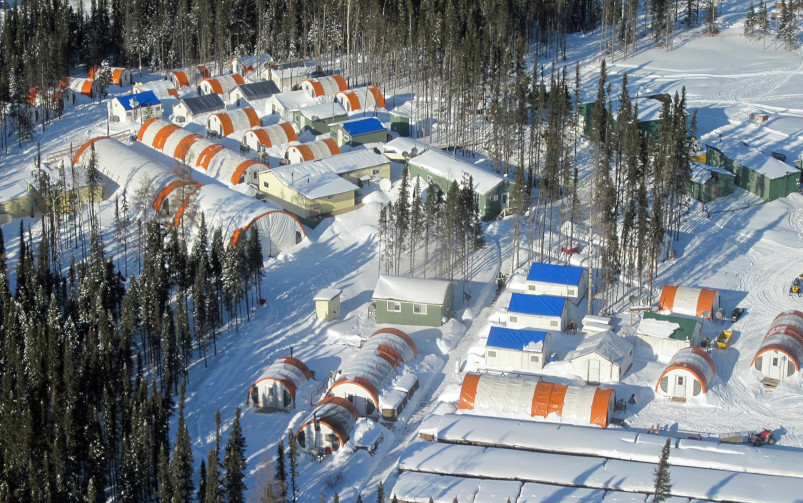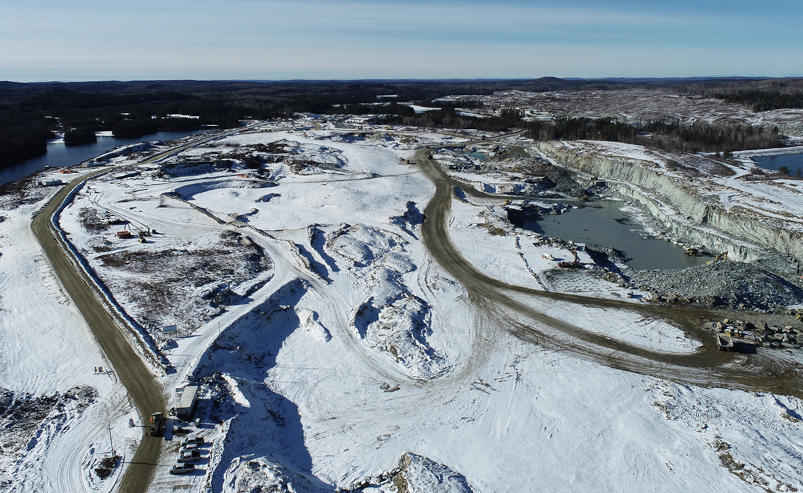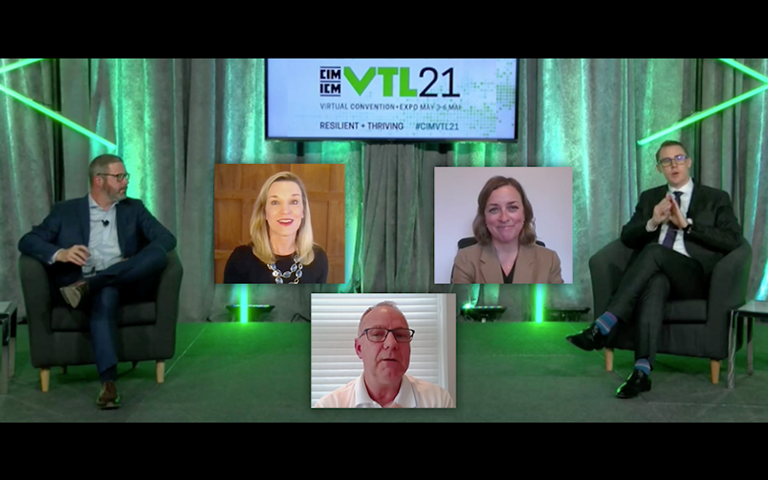From left to right: David Cataford, Denise Johnson, Mark Cutifani, Jody Kuzenko, Jerrod Downey.
The COVID-19 pandemic shook the entire world, and the mining industry was no exception. Although some parts of the world are beginning to see a light at the end of the tunnel through vaccinations, back in March 2020, when Canadian provinces and territories declared a state of emergency in response to the pandemic, no one quite knew what the future would hold. But it quickly became apparent that last year’s CIM convention planned for May in Vancouver would have to be cancelled.
Over a year later, it has been made clear that the industry has responded to the crisis in laudable fashion. The CIM Convention + Expo has made its return on a new, virtual stage as CIMVTL21. It is another example of how mining has adapted its operations significantly to mitigate the impacts of the pandemic. Fittingly, the first event of the convention, the opening plenary, spoke to the theme of the entire convention: “Resilient and Thriving.”
Hosted by Crownsmen Partners president Jerrod Downey, virtual attendees from around the world heard from four presenters: Jody Kuzenko, president and CEO of Torex Gold Resources; David Cataford, president and CEO of Champion Iron; Denise Johnson, group president at Caterpillar; and Mark Cutifani, chief executive at Anglo American. Every presenter touched on the theme of resilience and the changes they made because of the pandemic, but also the specific areas that they have focused on over the past year.
A priority for Torex Gold was improving diversity at its executive and managerial levels, but also at an operational level where the percentage of women employees is lower. According to Kuzenko, forward-looking mining companies have an “inclusion imperative.”
“When I talk about [the inclusion imperative], I’m talking about inclusion beyond gender. I’m talking about respect for host communities and Indigenous populations. The industry acronym for this today seems to be D&I, or ‘Diversity and Inclusion.’ This seems to have come to mean adding women and visible minorities to boards and couching that as a stat,” Kuzenko said. “In my mind inclusion, in particular, is about more than that. First, it’s an action, and it’s centred on this idea of taking discrete things and making them a part of a whole. And that action is underpinned by a feeling of belonging.” From Kuzenko’s perspective, miners must be prepared to include the experiences of the communities where they hope to operate in order to succeed. “In my mind, adopting an authentic stance of inclusion is imperative for obtaining and maintaining social licence.”
For Cataford, the pandemic presented numerous challenges working in an isolated region of Quebec, but it also presented opportunities to better connect with local communities and allowed employees to take their own initiative to solve problems. Cataford gave the example of one Champion employee who opted to spend $500 on chocolate to bring to the local community for Easter last year in order to make it a happier holiday under the circumstances.
“That probably had more impact last year with the local communities than hundreds of thousands of dollars that we invested in the year before. It was a big high in the town, and it made us realize that, one, we need to empower our employees to be able to do these small gestures in the community. Two, we need to cut the red tape to ensure that people who have these initiatives are able to deliver them very quickly and respond to different challenges that are specific in time. And three, employees need to understand that it’s important for us, as a company, for our people to be able to invest their time to be able to solve these smaller challenges,” Cataford said.
Johnson spoke about Caterpillar’s increased focus on safety, but also how the pandemic pushed a change in the way technology is used to conduct work at mine sites, with a big move towards virtual training and operations.
“As we were working with various mining companies to employ technology, [the conversation] was about how could we do it faster and how can we make sure we do it better than we had in the traditional way. In some ways, it really has sparked a number of changes to the way we operate and to training,” Johnson said. “In today's environment, we're doing a lot more work with virtually training or training remotely to be able to allow less site contact, especially for fly-in fly-out, where exposure could potentially be an issue, and trying to minimize that impact. Things like training remotely, software updates that we're doing now over the air when prior we'd send a team out to go and install those updates… Those kinds of changes, in addition to the expectation that deployment of technology has to happen under a much tighter window is something that really came about in this last 12 to 18 months.”
Cutifani went last to discuss the perception of the mining industry, and the benefits it provides society. According to Cutifani, the mining industry contributes to 45 per cent of the world’s economic activity through sales of commodities, which in turn supports other industries such as energy, agriculture, construction, transportation and more. Despite this, mining companies need to do more to fight the perception that as an industry mining “takes more than it gives.” Cutifani outlined three pillars for how Anglo American demonstrates its value to the public.
“For us, the first pillar was around a healthy environment, making sure we look after our neighbour’s back yards,” Cutifani said. “Second, to create a thriving community, because being a partner to a community is about making sure that community is successful. And then third, being a trusted corporate leader. Delivering these messages is absolutely critical, and the most important part of my job as chief executive of Anglo American.”
The changes necessitated by the pandemic could have lasting positive impacts down the road. When asked about the lesson the industry will learn from the past year, Kuzenko said, “For me, it really is centred around the theme of the CIM [event], which is resilience. You can be deliberate about building a skill set around resilience… and if you adopt that approach, that resilience is about moving through something and emerging more energized, elevated and equipped to handle what’s next. I think having that skill set deeply embedded in organizations will be extremely valuable for the industry moving forward.”




